Combination Impact of Turmeric Extract and Fermented Vinegar on Reduction of Inoculated Salmonella Typhimurium on Fresh Lettuce
Main Article Content
Abstract
The impact of turmeric extract (TE), fermented vinegar (FV) and the mixture (TE-FV) on reduction of Salmonella Typhimurium (ST) on lettuce was investigated. The TE-FV solution consisting of 0.05 mg/ml TE and 1.7% v/v FV, with pH 3.8 provided more impact of ST reduction on fresh lettuce than individual use of TE or FV (p ≤ 0.05). The results showed that the ST was gradually decreased for 3 log cycles from 7.11+0.1 log CFU/g to 3.60+0.1 log CFU/g after treatment of high inoculated ST (7.11+0.1 log CFU/g) by TE-FV for 20 min. Simultaneously, the complete inhibition of low level ST which initially inoculated for 3.14+0.1 log CFU/g was found. By the use of scanning electron microscope, it could be observed that the limit of ST inhibition was due to the irregularities of ST attachment on lettuce leaves. Moreover, the appearance change of un-inoculated lettuce leaves treated with TE-FV for 20 min was investigated. The slight changes in crispiness of lettuce leaves was generally noticed after storing at 4oC for 4 days. Therefore, it indicated that TE-FV solution has potential applicability as a natural sanitizer for improvements of microbiological quality and safety of fresh and fresh-cut fruits as well as vegetables in retail-catering industrial.
Keywords: turmeric extract, fermented vinegar, Salmonella Typhimurium, lettuce
E-mail: kkwaranu@kmitl.ac.th
Article Details
Copyright Transfer Statement
The copyright of this article is transferred to Current Applied Science and Technology journal with effect if and when the article is accepted for publication. The copyright transfer covers the exclusive right to reproduce and distribute the article, including reprints, translations, photographic reproductions, electronic form (offline, online) or any other reproductions of similar nature.
The author warrants that this contribution is original and that he/she has full power to make this grant. The author signs for and accepts responsibility for releasing this material on behalf of any and all co-authors.
Here is the link for download: Copyright transfer form.pdf
References
[2] Jay, J.M. 2000. Modern Food Microbiology. 6th ed. Gaithersburg, Maryland.
[3] Chandi, R.C., Dash, S.K. Mishra, R.K. and. Charyulu, J.K 2001. Anti E. coli activity of turmeric (Curcuma longa L.) essential oil. Indian Drugs, 38, 106-111.
[4] Singh, R., Chandra, R. Bose, M. and Luthra, P.M. 2002. Antibacterial activity of Curcuma longa rhizome extract on pathogenic bacteria. Current Science, 83, 737-740.
[5] Srinivasan, D., Nathan, S. and Suresh, T. 2001. Antimicrobial activity of certain Indian medicinal plants used in folkloric medicine. Journal of Ethnopharmacology, 74, 217-220.
[6] Martha, W. 1983. Encyclopedia of Chemicals Drugs and Biological, Merck Index 10th ed. New York.
[7] Krusong, W., Haruenkit, R. and Tum, S. 2007. Extending shelf life of dried yellow strip trevally fish stored at ambient temperature by vinegar. Proceedings of the International Conference on Integration of Science and Technology for Sustainable Development, Bangkok, Thailand. 26-27 April 2007, pp. 173-176.
[8] Kudkeaew, N. and Krusong, W. 2007. Effect of acetic on Salmonella Anatum reduction in vitro and in fresh pork quality. Proceedings of the 9th Agro-Industrial Conference. Food Innovation Asia 2007, “Q” Food for Good Life. BITEC, Bangkok, 14-15 June 2007, P307-NC.
[9] Yeesibsan, J. and Krusong, W. 2009. Reduction of Salmonella Enteritidis on surface of shell of chicken egg with dipping and spraying by fermented vinegar. KMITL Agricultural Journal. 27(3), 80-88.
[10] Jaroonrattanasakul, P. and Krusong, W. 2009. Effect of strawberry flavored-fermented vinegar on spoilage reduction of fresh strawberry by Botrytis cinerea. Proceedings of the KMITL Academic Conference and Presentation 2009. Office of Academic Administration. King Mongkut’s Institute of Technology Ladkrabang, Bangkok, Thailand, 31 August-2 September 2009. pp. 503-511.
[11] Sengun, I.K. and Karapinar, M. 2004. Effectiveness of lemon juice, vinegar and their mixture in elimination of Salmonella Typhimurium on carrots. International Journal of Food Microbiology, 96, 301-305.
[12] Kilonzo-Nthenge, A., Chen, F. and Godwin, S.L. 2006. Efficacy of home washing methods in controlling surface microbial contamination on fresh produce. Journal of Food Protection, 69, 330-334.
[13] Dansai, P. and Krusong, W. 2011. Effect of turmeric extract, fermented vinegar and theirmixture on Salmonella Typhimurium reduction in vitro. Proceedings of the International Conference on Biotechnology and Food Science-ICBFS 2011. Bali Island, Indonesia, 1-3 April 2010, S10004.
[14] Karapinar, M and Gonul, S.A. 1992. Removal of Yersinia enterocolitica from fresh parsley by washing with acetic acid or vinegar. International Journal of Food Microbiology, 16,261-267.
[15] Bolin, H.R., Stafford, A.E. King Jr. A.D. and Huxsol, C.C. 1989. Factors affecting the storage stability of shredded lettuce. Journal Food Science, 42, 1319-1321.
[16] Bhavani, T.N. and Sreenivasa, M.V. 1979. Effect of turmeric (Curcuma longa) fractions on the growth of some intestinal and pathogenic bacteria in vitro. Indian Journal of Experimental Biology, 17, 1363-1366.
[17] Fillion, L. and Kilcast, D. 2002. Consumer perception of crispness and crunchiness in fruits and vegetables. Food Qualities Preference, 13, 23-29.


